Table of Contents
How to Avoid PFAS in Cosmetics: Your Guide to Safer Beauty Products
This page may contain affiliate links. We may earn a commission on purchases, at no additional cost to you. Learn more →
Have you ever stopped to think about the ingredients used in our makeup products? If you're wondering how to avoid PFAS in cosmetics, you're not alone.
I always assumed that since cosmetic companies test their products, they must be safe - but that's not always true. Many everyday cosmetics contain harmful ingredients, including PFAS, known as 'forever chemicals', which are as the name suggests, a collection of toxic chemicals that stick around for too long.
As of 2024, the concern over PFAS in cosmetics has reached new heights. Recent studies and regulatory actions have put these 'forever chemicals' in the spotlight, making it more important than ever to understand how to avoid PFAS in your beauty products.
If this raises some red flags for you, then you are not alone, but by understanding PFAS and how to avoid them can empower you to make safer choices for your beauty routine and well-being. Let's dive into what PFAS are, how to spot them, and how to spot them, and steps you can take today to avoid these toxic chemicals.
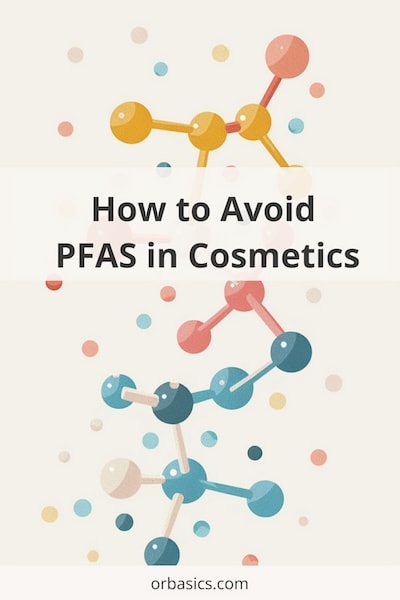
What are PFAS chemicals?
Per- and polyfluoroalkyl substances (PFAS) are a large collection of 15,000 synthetic, man-made chemicals, used in a range of products since the 1950's. PFAS are found in everything from food packaging, non-stick cookware, (yes, your teflon frying pan) to clothes, popular makeup products, furniture and carpets, and even tampons and other menstrual products!
Per- and polyfluoroalkyl substances (PFAS) include:
-
Perfluorosulfonic acid (PFSA)
-
Perfluorocarboxylic acid (PFCA), like Perfluorooctane sulfonic acid and its derivatives (PFOS) and Perfluorooctanoic acid (PFOA)
-
Usually in cosmetics:
perfluorooctyl triethoxysilane, polytetrafluoroethylene (PTFE), perfluorodecalin, perfluorononyl dimethicone.
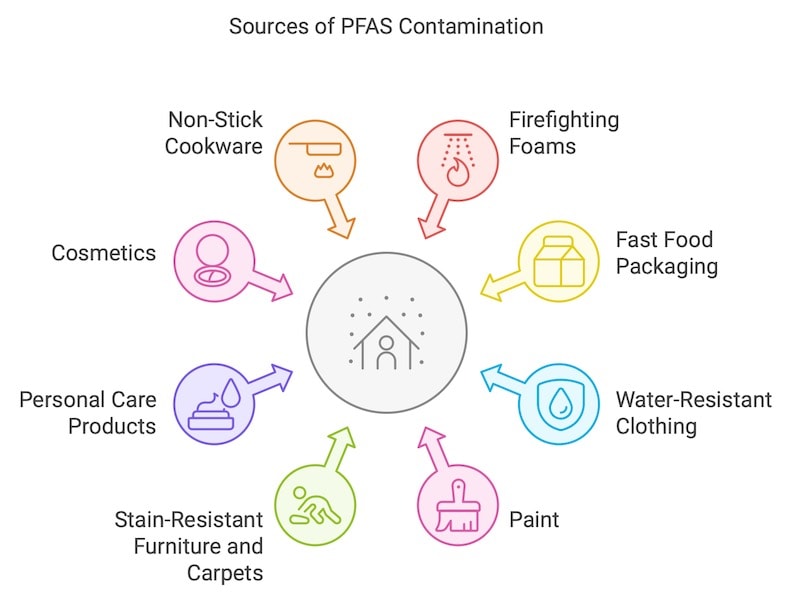
Are PFAS used in all cosmetic products?
PFAS are intentionally added to products to make them smooth, shiny, water-resistant and more durable etc. They are commonly used in most cosmetic products from your eyeliner and eyeshadows to your cleansers, nail polish and shaving creams. However, the products with the most significant amount of PFAS include waterproof mascara, foundations and lipstick.
In 2021, the Environmental Working Group (EWG) reviewed the Skin Deep Database of ingredients listed in all of its cosmetic products, and found 13 different PFAS chemicals used in over 300 products across 50 brands.
How to avoid PFAS in makeup?
PFAS will never be listed outright on cosmetics packaging, its crucial to know what you are looking and how to spot them on cosmetic ingredient lists. The easiest ways to are to:
-
Look for terms like 'waterproof', 'smudge-proof' or 'long-lasting'
-
Watch for ingredients that contain 'fluoro' in their names, as these ingredients are fluoropolymers, common examples include polytetrafluoroethylene (PTFE), perfluoroctoanesulfonate (PFOS) or perfluorooctanoic acid (PFOA)

Why PFAs matter: Understanding the Risks to Your Health and the Environment
PFAS chemicals raise concerns among scientists and public health officials, they're incredibly persistant and do not degrade easily due to their strong carbon-fluorine bond, meaning they build up in the environment, and in our bodies. Dr. Rhonda Patrick, a renowned expert in biomedical science and nutrition, explains, "PFAS are particularly troubling because they have half-lives that are several years long, meaning they persist in the body and accumulate over time."
When these chemicals enter our system - whether through ingestion, inhalation, or skin contact - they're rapidly absorbed and processed by our liver. But unlike many other toxins, our bodies struggle to break them down efficiently.
Exposure to Forever Chemicals: Health Effects
The health risks associated with PFAS exposure are still being uncovered, with ongoing research revealing a growing list of concerns. Your personal risk level depends on the amount of PFAS exposure, that is various factors, including the products you use, your living and working environment, and even the quality of your local water supply.
While the full extent of PFAS-related health issues is yet to be determined, several serious conditions have already been linked to exposure. Here are just a few known common health risks associated with PFAS:
-
Cancers (kidney, breast and testicular)
-
Pregnancy complications including preeclampsia (associated with maternal high blood pressure), increased risk of miscarriage and low birth weight
-
Thyroid disease, liver damage, increased cholesterol levels
These health risks underscore the importance of minimizing our exposure to PFAS, particularly in everyday products like cosmetics.
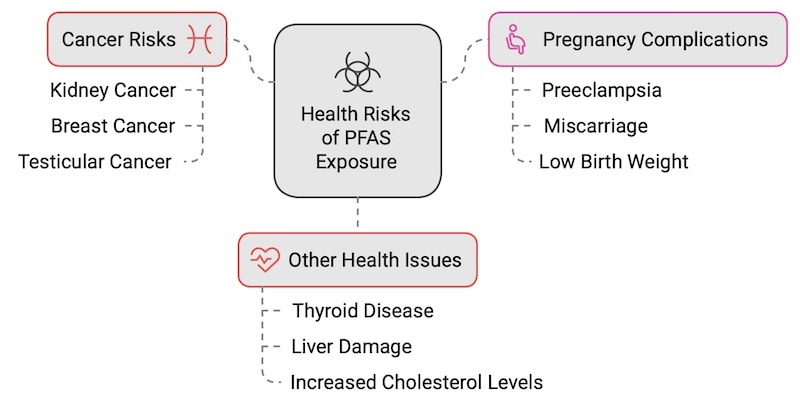
Environmental Health: The Impact of PFAS
Forever chemicals can take around 1,000 years to breakdown. Health and Environmental Aliliance (HEAL), reported that due to the widespread use of PFAS, it is estimated that round 12.5 million Europeans live in communities with drinking water contaminated with PFAS.
PFAS cannot be removed from water supplies through standard water treatment, these PFAS are then free to roam, flowing into seas, then eventually ocean circulations. It has been recently reported that PFAS have been found in our marine animals all over the world, from penguins to even polar bears!
Cosmetics' PFAS: How to Identify and Avoid Forever Chemicals
Researching Brands and Products
Luckily, there are things we can do to avoid PFAS in our daily lives especially when it comes to cosmetics, because who wants to give up makeup - not me. One of the things you can do today to start your journey into non-toxic holistic lifestyle, is familiarising yourself with common PFAS-containing ingredients. This is easier said than done, but fortunately there are ingredient checker apps that do this for us to decode products entire ingredient lists!
Here are a few apps you can use today:
-
EWG's Skin Deep
Another helpful thing to look for is clean beauty certifications, e.g. EWG verified products have very strict standards for health and transparency. However, there are many like certifications including USDA organic, COSMOS organic, MADE SAFE, EWG verified that can help you navigate clean beauty.
Decoding Labels: Misleading Marketing Tactics
Reading between the lines on product labels is important as most brands will use marketing language to make their products seem safer. Here are a few helpful terms to avoid being a victim to misleading marketing;
-
Green washing - brands can label their product as 'eco-friendly' or 'natural', but they can still contain PFAS, as these terms are not regulated, fluorinated compounds can be hidden under terms like 'conditioning agents' or 'film-formers'.
-
'Dermatologist-recommended' or 'hypoallergenic' - these terms do not guarantee a products safety or that it is PFAS, companies can use these terms without testing for ingredients like PFAS
-
'Fragrance' or 'parfum' - these terms alone can hide thousands of toxic ingredients, the term fragrance is also not regulated
If you really want to know how to steer clear of PFAS in your makeup bag, getting comfortable with those ingredient lists is key. We know it can be overwhelming, so we've put together a super helpful guide that breaks down how to read these tricky cosmetic ingredient lists: How to Read Cosmetic Ingredients Lists for in-depth information on navigating these often confusing labels.
Be also wary of 'BPA-free' labels on cosmetics and other products. Manufacturers often replace BPA with chemicals like BPS, which may have similar harmful effects.
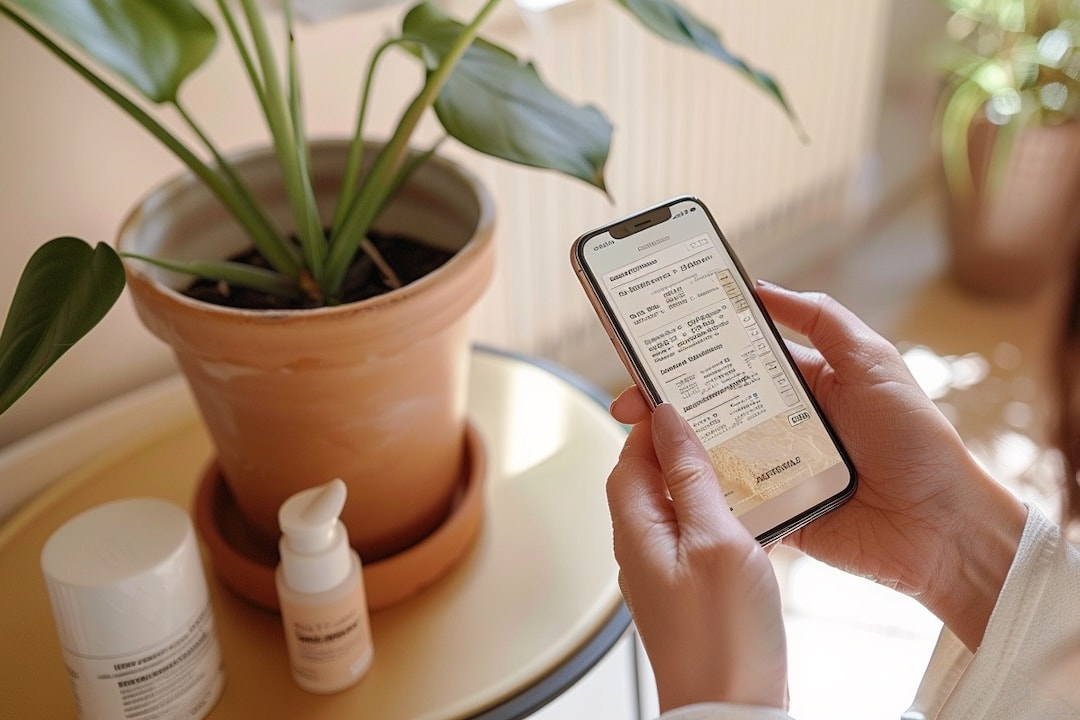
Regulating PFAS in makeup products
In many countries, especially the US, cosmetics and personal care products are under regulated, and there is a lack of transparency as to what goes into our makeup, especially around PFAS.
The FDA (Food and Drug Administration) recently updated their cosmetic legislation, called The Modernisation of Cosmetics Regulation Act of 2022, which enforces authority over cosmetic industries. This was the first major update to the cosmetic regulation since 1938!
As prior to this update, the FDA had no authority over cosmetic safety testing or pre-approving ingredients before a product hits the shelves, allowing PFAS to be used with minimal oversight.
Moreover, as of early 2023, several U.S. states have begun implementing their own PFAS bans in various products, including cosmetics. Maine, for instance, has passed a law requiring companies to report products containing intentionally added PFAS, with a complete ban set to take effect in 2030.
In April 2024, the EPA designated two widely used PFAS—PFOA and PFOS—as hazardous substances under the Comprehensive Environmental Response, Compensation, and Liability Act (CERCLA), also known as Superfund. This designation aims to improve transparency and accountability in cleaning up PFAS contamination
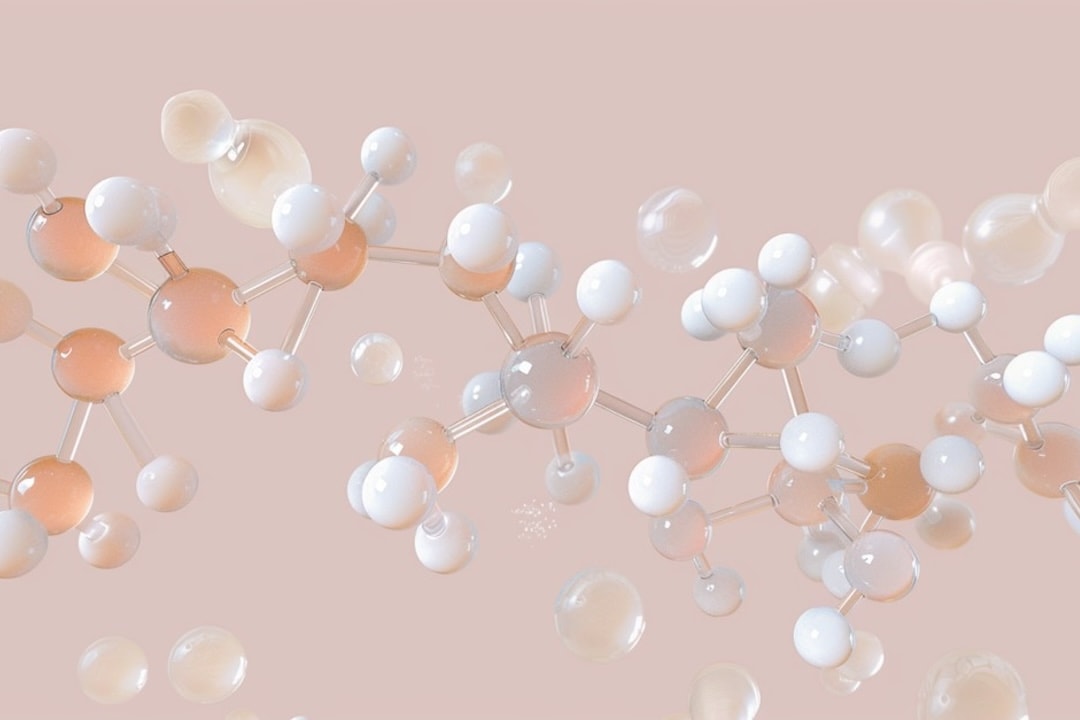
In Europe, there has been significant progress in this field, in comparison. In February 2023, the EU Chemical Agency (ECHA) published a draft proposal for a restriction on the production of PFAS, in Europe. Today, HEAL and with more than 100 other civil societies are calling to #BanPFAS, which includes to ban PFAS contains products by 2025, and to have this completed by 2030 to help remove PFAS from the environment for our safety.
Countries like Canada are also taking steps to regulate PFAS through comprehensive risk management plans that assess environmental and human health impacts
In an effort to move towards cleaner beauty, Sephora now have a curated collection of products called the 'Clean at Sephora', which are formulated with safer formulations, free from a wide range of toxic ingredients including PFAS!
These developments reflect a global trend towards stricter regulation of PFAS to protect human health and the environment. The regulatory landscape is expected to continue evolving as more scientific evaluations are completed and new regulations are implemented.
Supporting Your Body's Natural Detoxification
While the primary focus should be on avoiding PFAS in cosmetics and other products, it's also important to support our body's natural detoxification processes. There are strategies that may help our bodies eliminate toxins more efficiently, like:
-
Boost sulforaphane intake: Incorporate broccoli sprouts and other cruciferous vegetables into your diet. Sulforaphane has been shown to activate detoxification enzymes in the body, potentially helping to process and eliminate harmful chemicals like those found in some cosmetics.
-
Increase dietary fiber: A high-fiber diet can bind to toxins in the digestive tract, potentially reducing their absorption and promoting their excretion. This could be particularly beneficial when it comes to ingested toxins from lip products or hand-to-mouth transfer of cosmetics.
-
Sweat it out: Engaging in activities that promote sweating, such as exercise, sauna use, or hot yoga, may help eliminate trace amounts of harmful chemicals through sweat. While most PFAS are eliminated through urine, some studies have shown that sweating can also contribute to the excretion of certain toxins.
While these strategies may support overall health and detoxification, they are not a substitute for avoiding PFAS and other harmful chemicals in the first place. The most effective approach is to combine mindful product choices with a healthy lifestyle that supports your body's natural detoxification processes.
Key Takeaways
-
PFAS are synthetic chemicals, used in a range of our cosmetic products, used to make them durable and water resistant. These ingredients are not always disclosed but can be identified by use of the words 'flouro' or 'long-lasting'
-
PFAS or 'forever chemicals' do not break down easily, resulting in accumulation the environment and the human body. Exposure to PFAS has been linked to various health issues including, cancers, pregnancy complications and organ damage
-
You can avoid PFAS by simply swapping to PFAS-free products, and scanning your existing beauty products for fluorinated compounds. Using apps like EWG's Skin Deep or Think Dirty can assist you in identifying safer cosmetics.
-
Many brands are PFAS-free, offering many PFAS-free makeup and skincare options, brands like ILIA beauty, 100% Pure and RMS Beauty, and more, offer good alternatives. Clean beautify certifications like 'EWG verified' are always helpful in identifying clean brands too.
-
There are things being done within the industry to address PFAS in cosmetics, so do not fret! Updates to existing legislation in the EU and the US, are becoming stricter, however, minimising your own risk to PFAS is also important!
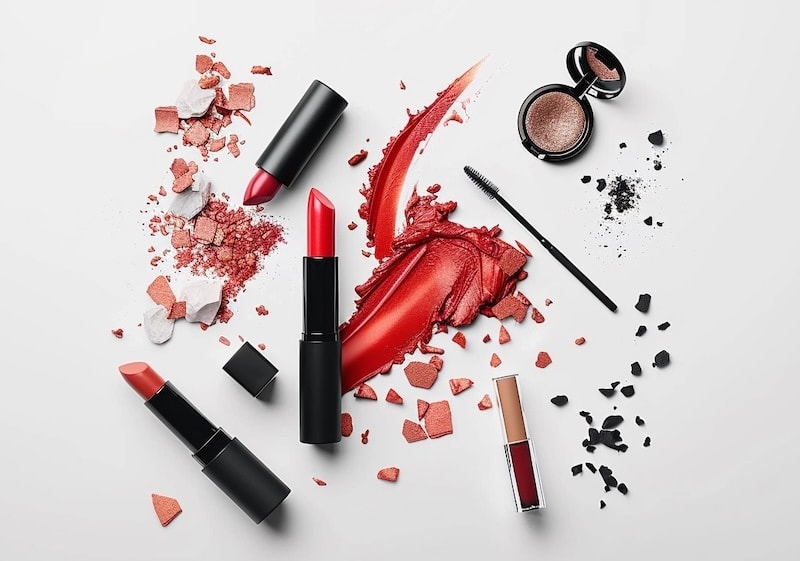
Which cosmetics are PFAS free?
There are many non-toxic makeup brands that use PFAS-free formulas, with many brands offering PFAS-free ranges, the switch to a non-toxic products has never been easier.
Here are a few of the best and trustworthy brands on the market which offer PFAS-free makeup and skincare:
For more in-depth information on reducing your exposure to PFAS and other harmful chemicals, check out Dr. Rhonda Patrick's comprehensive video on the topic! This resource offers additional strategies and insights that complement our guide on avoiding PFAS in cosmetics:
FAQ to avoiding PFAs
How do I know if my makeup has PFAS?
To determine if your makeup contains PFAS, check the ingredient list for terms like "perfluoro" or "polyfluoro," which indicate the presence of these substances. Additionally, using apps or databases such as EWG Database or CosmEthics can help identify PFAS-containing products by cross-referencing ingredient lists against known PFAS compounds
How do I protect myself from PFAS?
Protecting yourself from PFAS involves choosing products from brands committed to non-toxic formulations and transparency. Find makeup and skincare products that explicitly state they are free from PFAS and other harmful chemicals. Supporting brands with certifications like EWG Verified can also ensure safer choices.
How can PFAS be prevented?
Preventing PFAS in cosmetics requires stricter regulations and better industry practices to eliminate these substances from product formulations. You can advocate for change by supporting brands that prioritize clean beauty standards and by demanding transparency and accountability from cosmetics companies regarding their ingredient sourcing and product safety













